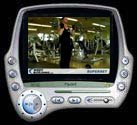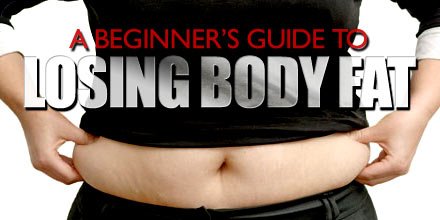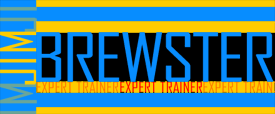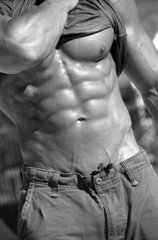 | The first thing I'm going to tell you is, don't go on a diet. Why? Because most diets are not based on sound nutritional principles... Breakthrough the fat by learning more from the following principles, nutrition tips, calculators and workouts! |
The purpose of this article is to give the beginner a simple, uncomplicated approach to eating and exercising with the goal of losing body fat. A beginner is defined as someone with 2-4 months training experience, or someone who's been training longer but feels they haven't been making good progress.
Want to lose body fat? The first thing I'm going to tell you is, don't go on a diet. That's right, going on a diet is the biggest mistake you can make.
Why? Because most diets are not based on sound nutritional principles, are hard to follow, and most of all, make no long term provision for maintaining your weight loss. In other words, when you go on a diet, you eventually go off the diet and do what? Go right back to the eating habits that caused the weight gain in the first place. Besides, some of these diet ideas are way out there.
How many of you have heard the "10 pounds of compacted waste stuck somewhere in your system" commercial? And of course, getting that "bowling ball" out of your system is the key to fat loss. Please.
Before we go further, let me define something. There's a definite difference between losing weight and losing fat. Most people don't understand that to lose weight means to lose muscle, water and fat. That's not what we want. What we want is to lose fat and keep the muscle. Muscle requires more calories to maintain it, and that means a better supported metabolism, so there's a definite advantage to building more muscle.
So if going on a diet doesn't work, what does? The answer is to make healthy lifestyle changes you can live with. This refers to both your eating habits and your activity level. Right off the bat, you want to dramatically decrease your sugar, or simple carb intake, and your fat intake.
High protein, moderate carb (mostly slow or complex carbs), and low fat is the way to go. As well, you want to eat 5-6 small meals a day, not 3 big ones (or worse yet, starve yourself on 1-2 meals). You also have to add a cardio program. Fat loss is not only a function of calories in/calories out but also the type of calories and the timing of those calories and you must be burning more calories through physical activity than you are taking in.
Beginning Bodybuilding Basics:

Food Serves A Very Functional Purpose
It's not here just for taste, although most people see taste as the sole point. Many of us, myself included, grew up eating nothing but junk and never knowing anything about nutrition. I never heard the terms "protein" "carbs" or "fat" as a kid. And in those days, they didn't have nutrition panels on food labels.
Ignorance of what people eat is why there are so many over weight people today. The food industry hasn't helped, look at what's out there - fast food, junk food, processed food, it's no wonder so many people have a hard time with their weight.
The function of food is to supply energy and nutrients to the body, eating for taste is secondary. That doesn't mean you shouldn't enjoy the taste of what you eat, but an understanding of what you should eat will lead you to make better choices.
Food consists of three macro nutrients:
Your body, after water, is mostly made of protein. You require protein every day, it performs literally thousands of functions in the body. It does this in the form of different combinations of amino acids, the "building blocks" of protein.
Carbohydrates are the preferred form of fuel for the body's energy needs. Simple or sugary carbs have there place but for the most part you should eat complex or slow burning carbs. An important point about carbs and where the average person makes there mistake is that after you supply your energy needs, any excess carbs will be stored as fat.
Think of this as similar to filling your car's gas tank - once the tank is full, if you keep pumping, you will have a lot of excess gas spilling out all over the place. Once your energy needs are met and you keep eating high carb meals, the excess "spills out" and you get fatter.
As for fat, there's good and bad types of fat, I will list what you should eat and what you should avoid later. Most of us eat way to much fat, primarily the bad types of fat, such as saturated fat and trans fat. Proper food choices/quantities can take care of this problem. So by reducing sugar, fat and total calorie consumption, we can control the food part of the equation, we'll cover the exercise part in a bit.

Goal Setting
Determining body fat % and total daily calorie requirements - setting reasonable goals as far as fat loss is essential. How much do you want to lose?
 Body Fat Percentage:
Body Fat Percentage:
Step 1 to doing this is to know how much fat you currently have. The next step is to determine your daily calorie needs. There are actually several formulas to figure this out but we'll use the following formula: For men, you'll need your weight and waist size for this. The one for women will follow.
Men:
Multiply your body weight by 1.082, add 94.42 to the result, save this number and then multiply your waist size by 4.15. Subtract this result from your first number, this is your lean body weight. The difference between this and your true body weight indicates how much fat you have.
Women:
For women, the formula is more complicated and is as follows: take five measurements - body weight, wrist circumference at the widest point, waist size at the navel, hip circumference at the widest point and forearm size at the widest point.
Now do the following:
Daily Calorie Needs:
- Sedentary lifestyle (sitting a lot, no real exercise) = 1.1
- Mildly active - standing at work, 2-3 workouts a week = 1.2
- Very active = 1.3
- Fast metabolism = 1.1
- Average = 1.0
- Slow = .9
There are several formulas to determine your daily calorie needs, I suggest the following formula, which takes into account your metabolism and activity level.
Here's what you do:
body weight x 10 (men) or 9 (women) x activity factor x metabolism level.
Activity factor is determined like this:
Metabolism level is determined like this:
Here's an example for a 170lb man: 170x 10 = 1700 x 1.2 (mildly active) = 2040 x .9 (slow metabolism) = 1836 calories per day. So you have a daily calorie total that should then be divided by 5-6 to give you a idea of the calorie content of each meal.
You don't have to count all your calories in all your food all the time. However, that is a very accurate approach, and in a very short time, you can know what you're taking in without writing everything down.
Other systems have you using a predetermined portion size, like your palm or fist but this doesn't seem very accurate. This approach requires knowing the macro nutrient breakdown of the portion size. I suggest staying with a specific food list and counting calories for a week or two so you know where you stand and so you can easily make adjustments if you need to.
As your meal planning becomes routine and you're working off a standard list of foods and you're at a certain calorie level, you no longer need to count calories, you'll know what and how much you should be eating at each meal.
 Macronutrients:
Macronutrients:
- Lean red meat
- Chicken (no skin)
- Turkey
- Fish
- Low fat dairy - except for eggs
- Going Against The Grain. - By Dr. David T. Ryan
- Everyone Should Know About The GI! - By Fawnia Mondey
- FAQs About The Glycemic Index (GI)! - By Mauro Di Pasquale
- Other Glycemic Index Articles...
- Sweet potatoes
- Yams
- Beans
- Corn
- Brown rice
- Oatmeal
- Whole grain products
- Veggies(these are fibrous carbs) and fruits such as strawberries
- Bananas
- Pears
- Grapefruit
- Apples
- Cookies
- Cakes
- Pastries
- Candy
- White flour
- High sugar foods
- Cold water fish
- Low fat cheeses
- Sunflower seeds
- Walnuts
- Almonds
- Peanut butter
- Olive oil
- Canola oil
- Safflower oil - eat these in moderation
- High fat meats
- High fat dairy
- High fat salad dressings
- Deep fried foods
- Butter
Set up your macro nutrient proportions as follows:
50% protein, 30-35% carbs and the remainder in healthy fats. Carb intake should be a little higher on weight training days to provide enough energy. On cardio days, you'll lose fat faster if you work out on an empty stomach (although a small protein shake isn't a bad idea).
Any one who reads my articles know I talk a lot about the post-workout shake, this is the best time for simple carbs. On non-cardio days, you can start your day with some simple carbs as part of a protein shake or high protein meal.
Protein Choices:
Good Protein Foods:
Don't be afraid to eat whole eggs as most of the nutrients are in the yolk. Avoid processed meats, high fat meat and full fat dairy.
Carb Choices:
Good Carb Foods: at this point, I'll make reference to the Glycemic Index, which is a measure of a food's ability to elevate blood sugar, and the Glycemic Load, which is the glycemic index of a food multiplied by it's carbohydrate content in grams, which tells you how much carbohydrate is in a food.
Glycemic Index:
In both cases, the lower the number, the better the carb choice. Best carb choices that are low on the GI scale are:
Carbs To Avoid:
Fat Choices:
Good Choices:
Avoid:

Meal Plan
Here's a sample meal plan for one day:
 Breakfast:
Breakfast:
- 1/2 cup Oatmeal, flavored with cinnamon and 1 apple cut up into chunks.
- 3 whole eggs (yes, include the yolks!) any style ( do not fry in butter) and water.
- 1 banana
- 2 scoops of whey protein in 8 oz. water
Optional to this is the "I'm to rushed to eat breakfast" breakfast:
Breakfast is a critical meal, do not blow it off. To many people think the key to weight loss, and I hear it every day, is to just "tape my mouth shut and not eat". What a mistake. Keep your metabolism active by supplying small, evenly timed (every 3 hours) meals. Starve and your metabolism shuts down.
| RELATED ARTICLE | ||
|
 Mid-Morning Snack:
Mid-Morning Snack:
- Low fat/sugar/high protein bar
- Protein shake
 Lunch:
Lunch:
- 6 oz. chicken
- 1/3 cup brown rice
- Some mixed veggies
- Water
 Mid-Afternoon Snack:
Mid-Afternoon Snack:
- Yogurt or 1/2 cup cottage cheese
- Protein shake
 Dinner:
Dinner:
- 6 oz. lean steak
- Sweet potato
- Steamed carrots
- Water
 Snack:
Snack:
- Protein pudding: 3/4 cup no fat milk
- 2 scoops whey protein powder
This meal plan is just an example, in reality your portion sizes would be determined based on the calorie content of each food choice and your daily needs. Fibrous carbs are a good choice because the body does not digest them, you can eat this type of food a lot and not have to worry about fat storage.
As well, you can enjoy low/no fat, low/no sugar "desert" type foods to keep a plan like this from being to bland, also use seasoning to add flavor to meats for the same reason.
The key here is to not go above your daily calorie allotment. Having said that, it is common to "zig-zag" calorie totals: if you have a daily calorie allotment of 2200, you can eat within that range, 1800 one day, 2400 the next, 1950 the next, as long as you are averaging 2200 over the course of the week.
As for cheat days or meals, I personally would rather have a healthy alternative that works with my eating plan, than to go nuts one day a week and eat like a pig. Not to mention I personally would find it to hard to get strict again the next day.
As for pre/post workout shakes, I suggest a creatine drink during your workout, and a typical post workout shake afterwards: simple carbs and protein, 40-60 grams of each, unless you're doing cardio after weights, then I suggest a small amount of protein, maybe 15-20 grams just before cardio, then the full shake after cardio. Within one hour, have whatever meal corresponds to that time of day.
Exercise Guidelines - Weight Training & Cardio
Any routine involving both weights and cardio should be flexible enough to be adjustable to individual lifestyles.
 Routine #1: 3 Day Split:
Routine #1: 3 Day Split:
- Bench press - 3 warm-up sets with a light weight for 15, 12, 10 easy reps; 3 working sets - 8-10 reps
- Dumbbell Flyes - 3 sets, 10 reps
- Deadlifts - 3 warm up sets, for 15, 12 10 reps; 2 working sets of 6-8 reps
- Bent rows - 3 working sets, 8- 10 reps
- Lat Pull-downs - 3 working sets of 8 - 10 reps
- Crunch - 3 sets of 35 reps
- Squats - 3 warm up sets of 15, 12, 10 reps, 3 working sets of 6-8 reps
- Leg extensions - 3 working sets of 10 - 12 reps
- Leg curls - 3 working sets of 10 - 12 reps
- Crunch - 3 sets of 35 reps
- Clean and press - 3 warm up sets of 10 reps; 3 working sets of 8 reps
- Dumbbell laterals - side and rear done as a super set - 3 sets of 10 - 12 reps
- Standing EZ bar extensions - 3 sets of 8 reps
- Tricep press downs - 3 sets of 10 reps
- EZ bar curls - 4 sets of 10 reps
- Incline Dumbbell curls - 2 sets of 8 reps
- Twisting crunch - 4 sets of 25 reps
Day 1: Chest/Back, Abs, Cardio Optional
Day 2: Cardio
Day 3: Legs, Abs
Day 4: Delts, Arms, Abs, Cardio Optional
Day 5: Cardio
Day 6: Cardio
Day 7: Rest
Variation #1
 Workout Variation:
Workout Variation:
Replace straight sets with supersets. I like to alternate same muscle supersets one week with opposing muscle supersets the next.
 | Superset Video WMV (7.9 MB)MPEG (6.2 MB) Video iPod (.8 MB) |
Depending on your metabolism and how much fat you have to lose, cardio can be added to your weight training days, weights first, cardio after. Length of cardio sessions: 20-30 minutes. So you're doing cardio at least 3 times a week, more if the need is there.
These are splits are designed to fit in an active lifestyle. Cardio on non training days can be done when you have time but it's best to do it in the morning on an empty stomach. If that's not possible, do it later after dinner. Cardio done in the morning and after weights will burn fat for fuel as opposed to burning carbs.
 Cardio Technique:
Cardio Technique:
- Interval Training: Sport-Specific Conditioning. - By Craig Ballantyne
- Interval Training 101. - By Peak Performance
- The Insider Secrets Of Interval Training! - By Nick Nilsson
- Other Interval Training Articles...
Interval training - this is a high intensity method of cardio that can allow you to use less time to get your sessions done in. It works like this - warm up at the cardio exercise of your choice at a moderate pace for about 2 minutes. Then speed up to a high level for about 1 minute, back off to a slow pace for 1 minute, then back up and so on.
Interval Training:
Allow a 2-3 minute cool down at a slow pace at the end. The time spent doing this depends on how out of shape you are, you may only be able to handle 5-10 minutes at first.
Work your way up to 20 minutes and I would suggest using more standard cardio tempos along with interval cardio until you get into good enough shape to handle 100% interval cardio at every session. Standard cardio tempo means you're moving at a brisk pace, a little winded but able to carry on a conversation if you had to.

Conclusion
Well, that's it. Dedicate yourself to results and you won't be disappointed. Good luck!






















1 comment:
common mistakes in muscle building
https://www.famfits.com/11-most-common-mistakes-in-bodybuilding/
Post a Comment